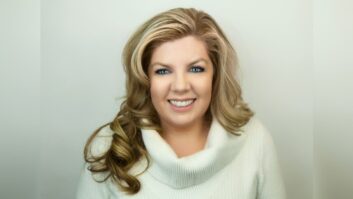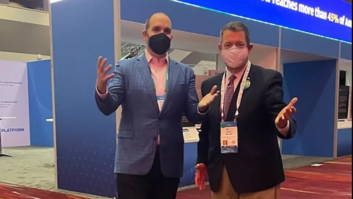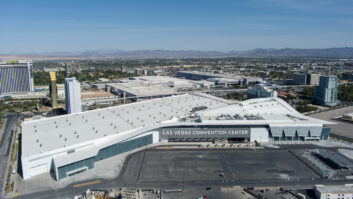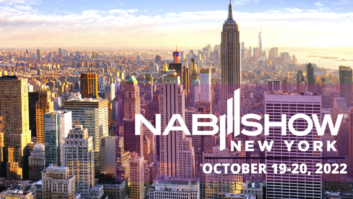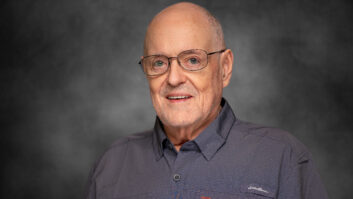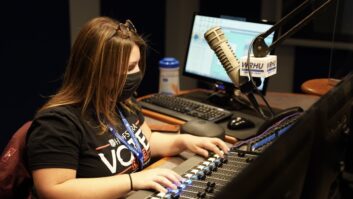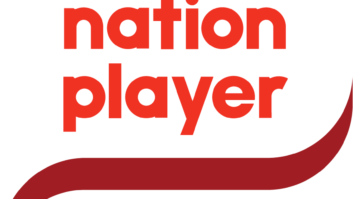Lotus Broadcasting’s New Las Vegas Operation
Apr 20, 2002 12:00 PM


By Bill Croghan
After years of planning and lots of sweat, Lotus Broadcasting, Las Vegas, moved KOMP,KXPT,KENO and KBAD into its new 13,300 square foot space on the first floor of the building on July 1, 2001. It was an experience I’ll never forget. The building was built from the ground up to our specifications to house the entire business and operations facilities.
The sign welcoming you to the Lotus facilities.

The Radio station has four main studios, two production rooms, two edit bays and a voice booth. The studio and production areas are built with staggered-stud wall construction, non-parallel walls, isolated ceilings and vibration-isolated concrete floors. All the conduits are run under the concrete to a central staging area. Each room has a closet-sized breakout box where the multiple Belden 32-pair cables terminate on custom circuit boards.
We use a terminal board that was designed in-house, which allows room for labels on everything and plug-in headers on the non-permanent side of the board. All the cable is Belden 32-, 16- and single-pair wire. From the breakout boxes to the equipment in the rooms and between connections on the staging area wall, Belden 9241 was used. All the digital signals are carried on AES3-rated wire. The telephone and computer cabling was contracted to Netversant, a local contractor. All of this cable is CAT5E compliant. All the computers have an uninterrupted cable run to the network server room where they are connected to high-speed switches.
Inside the breakout box showing the custom terminal boards.

A design element was introduced by the architect, who surprised us with some shelving with 3-inch copper tubing for supports. It looked very sharp, but any radio engineer would see it and think that it was actually rigid transmission line. We stayed with this theme and used 3-inch and 1-inch copper tubing for many construction elements through facility. The studio speakers, mostly large JBL models, are hung with custom-made, U-shaped wood brackets, which are attached to the hard ceiling with 1-inch pipe. A 3-inch copper tube was placed over the 1-inch tube to enhance the appearance. Also, each breakout box has a 1-inch copper tube going to the ceiling to carry speaker wires and other cable connections.
The custom-made speaker hangers.

A custom stand for the 360 Systems Shortcut showing the copper theme.

All the lighting is incandescent with dimmer controls. We were prepared to eliminate electrical dimmer noise, but so far have not had any problem. We also were careful to avoid using any neon signs, but one of our program directors surprised us by purchasing a huge neon logo, which he wanted hung in the control room. While the flicker annoys some of our operators, our attention to good grounding, strict conformance to wiring standards and good equipment have prevented any noise problem.
The neon sign that never really became a problem.

The on-air consoles are Harris Impulse 20- and 12-channel boards. Looking back, we should have used only the 20-channel versions throughout to allow the extra input capacity. Each FM studio has a 100 percent redundant computer system on the Macro Media Air Force digital program system. About 95 percent of our music is dubbed in an uncompressed format into the system. There is a single redundant computer for the AMs. Any room can run fully automated or live-assist as needed.
Two views of different on-air studios.


Production rooms and edit bay have Panasonic DA7 consoles and are digitally linked to the computers using SAW Studio Light. We use CDs, and Minidisk extensively and DAT to lesser degree, although we are moving to CD as our standard for storage and transport. Production spec pieces are dubbed to cassette. There is one reel-to-reel deck in the facility. There are no carts, and if absolutely needed, we can bring in a turntable.
An edit booth with DA7 console.

The FM STLs use Mosley transmitters with DSP6000 digital codecs. Both FMs are located on Mt. Potosi, about 23 miles line of site. The trip by road is about 50 miles, the last five of which are only accessible by Snowcat during parts of the winter.
We have a two backup FM transmitters on Mt. Arden just south of town, which provide about 2kW ERP. The AMs use equalized telephone lines for STLs.
On-air phones are handled with Gentner and Telos equipment. We have three ISDN BRI pairs and use Telos Zephyrs, and Comrex Nexus, Hotline, Vector and Blue Box units for remotes in addition to some Marti RPU equipment.
The new Lotus Las Vegas building was made possible through the hard work of J.D. Davis, B.H.Belter, Mike Lyles and the general contractor, Investment Equity.
Notes on planning
Double check everything with the architects, refrigeration engineers and electrical engineers throughout the project. Do it with every revision. Watch for simple cost savers that will burn you. If a room needs two outlets, put in four on two separate circuits. Think about each piece of equipment and where it will plug in, where its input comes from and where it goes. Give yourself plenty of space for everything and then add 15 to 20 percent. Be sure to check the ADA requirements when planning studio furniture. Give yourself plenty of outlets and separate circuits in the control rooms. Have at least one isolated circuit for the studio equipment. A TV crew with lights will draw lots of current, and you don’t want to blow a breaker at that time.
Plan for redundant air cooling for the equipment areas and try to separate the studio and hallway air conditioning so that doors can be left open if a studio AC fails.
Put good ground stakes in each room during construction and connect each area with a good quality copper strap. Give your self plenty of overhead in the breakout boxes. Figure your maximum needs, double it, then double again. Allow plenty of extra conduit for later expansion.
Our biggest problem was with the phone company on the day of the move. Only about half the lines were ready despite assurances to the contrary. The contractor and the telephone company had not coordinated on the types of lines needed for DID, but were able to get us up and working temporarily due to some great work by the field technicians Two remote-control dry pairs had been ordered as 8kHz equalized one-way lines. While the field technicians caught and corrected this problem, we are still trying to get the billing straightened out after nearly one year.
Contract a local mover to take care of physical moves. Office people should move personal things personally. Equipment should be labeled by room and moved by engineers, not moving people. Let the staff know that you will not have time to hang pictures, adjust chairs, hookup office computers or move their plants during the technical move. Buying new furniture and having it in place ahead of time makes more sense than moving old furniture into the new facility. Little things like door stops can be a big headache if not planned.
Enjoy your new facility planning and implementation. It will be nice to know that now you only have to face your own mistakes, not those of a dozen predecessors.
Croghan is chief engineer of Lotus Las Vegas.





